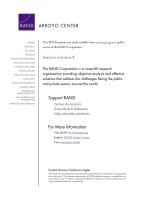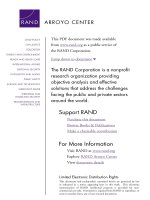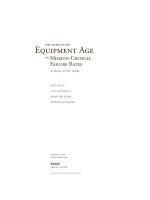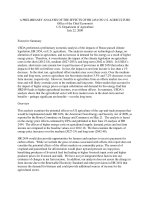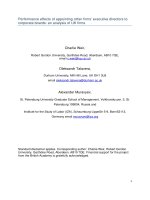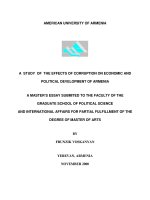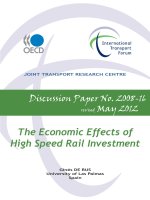- Trang chủ >>
- Y - Dược >>
- Vi sinh học
EFFECTS OF DIETARY SUPPLEMENTATION OF ORGANIC TRACE MINERALS ON GROWTH PERFORMANCE OF NURSERY PIGS
Bạn đang xem bản rút gọn của tài liệu. Xem và tải ngay bản đầy đủ của tài liệu tại đây (243.45 KB, 5 trang )
<span class='text_page_counter'>(1)</span><div class='page_container' data-page=1>
contain a very little amount of those minerals to
cover the young pigs’ requirements for optimal
productivity, dietary supplementation of those
trace elements for fast-growing piglets are
<b>INTRODUCTION</b>
Microminerals, especially Zn, Cu, Mn and
Fe, are essential nutrients for maintenance
and production of animals. As common diets
<b>EFFECTS OF DIETARY SUPPLEMENTATION </b>
<b>OF ORGANIC TRACE MINERALS ON GROWTH </b>
<b>PERFORMANCE OF NURSERY PIGS</b>
<i>Che Minh Tung1<sub>, Sutep Luengyotluechakul</sub>2</i>
<i>1<sub>Nong Lam University, Ho Chi Minh City, Vietnam</sub></i>
<i>2 <sub>Zinpro Animal Nutrition Inc., Thailand</sub></i>
<i>Email: </i>
<b>ABSTRACT</b>
<i><b>The experiment was conducted to evaluate the effects of dietary supplementation of organic </b></i>
<i>trace minerals (Availa-Starter 123®<sub>) on growth performance of nursery pigs. One hundred and </sub></i>
<i>eighty crossbred weaned pigs [(Yorkshire-Landrace) x Duroc; 28 d old; 7.45 ± 0.90 kg of BW] </i>
<i>were randomly allotted to 2 treatments in a randomized complete block design. The 2 experimental </i>
<i>treatments included (1) basal diet with inorganic trace minerals (Control) and (2) As 1 + 0.175% </i>
<i>Availa-Starter 123. Pigs were blocked by their initial body weight. Sex and ancestry were equally </i>
<i>distributed across treatments. There were 15 pigs/pen and 6 replicate pens/treatment. The ADG of </i>
<i>pigs fed the Availa-Starter 123-supplemented diet (368.2 g) was greater than (P = 0.021) that of </i>
<i>pigs fed the control diet (345.3 g) during the experimental period. The Availa-Starter 123 increased </i>
<i>(P = 0.020) the final BW of pigs (18.14 kg/pig) when compared with the control (17.55 kg/pig). </i>
<i>The diet supplemented with Availa-Starter 123 did not affect ADFI and F:G of pigs as compared </i>
<i>with the control (P > 0.05). No differences in the mortality, incidence of diarrhea, and number of </i>
<i>antibiotic treatments between the two treatments were found (P > 0.05). Briefly, addition of </i>
<i>Availa-Starter 123 to a commercial nursery diet containing inorganic trace minerals improved the growth </i>
<i>performance of pigs as it increased the ADG and final BW of pigs.</i>
<i><b>Keywords: growth performance, nursery pigs, organic trace minerals </b></i>
<b>TĨM TẮT</b>
<i>Thí nghiệm (TN) được tiến hành nhằm đánh giá ảnh hưởng của việc bổ sung khoáng hữu cơ </i>
<i>(Availa-Starter 123®<sub>) vào thức ăn (TA) đến khả năng sinh trưởng của heo sau cai sữa. Tổng số 180 </sub></i>
<i>heo cai sữa lai [(Yorkshire-Landrace) x Duroc; 28 ngày tuổi; khối lượng bắt đầu TN: 7,45 ± 0,90 </i>
<i>kg] được bố trí ngẫu nhiên vào 2 nghiệm thức theo kiểu khối hoàn toàn ngẫu nhiên 1 yếu tố. Hai </i>
<i>nghiệm thức TA gồm (1) TA cơ bản có khống vơ cơ (Đối chứng-ĐC) và (2) ĐC + 0,175% </i>
<i>Availa-Starter 123. Heo được phân khối dựa vào khối lượng cơ thể lúc bắt đầu TN. Heo giữa các nghiệm </i>
<i>thức đồng đều về giới tính và nguồn gốc ổ đẻ. Mỗi nghiệm thức có 6 ơ chuồng và mỗi ơ chuồng </i>
<i>có 15 con heo. Tăng trọng hàng ngày của heo ăn TA có Availa-Starter 123 (368,2 g) cao hơn (P = </i>
<i>0,021) tăng trọng hàng ngày của heo ăn TA ĐC (345,3 g) trong thời gian TN. Availa-Starter 123 đã </i>
<i>làm tăng khối lượng cơ thể heo lúc kết thúc TN (18,14 kg/con) khi so với ĐC (17,55 kg/con). Thức </i>
<i>ăn có bổ sung Availa-Starter 123 đã khơng ảnh hưởng đến tiêu thụ TA hàng ngày và hiệu quả sử </i>
<i>dụng TA của heo khi so với ĐC (P > 0,05). Khơng thấy có sự khác biệt về tỷ lệ chết, tỷ lệ tiêu chảy </i>
<i>và số lần điều trị kháng sinh giữa 2 nghiệm thức (P > 0,05). Tóm lại, bổ sung Availa-Starter 123 </i>
<i>vào TA thương mại có chứa khống vơ cơ cho heo cai sữa đã cải thiện khả năng sinh trưởng của </i>
<i>heo vì nó đã cải thiện tăng trọng hàng ngày và khối lượng cơ thể của heo khi kết thúc TN.</i>
</div>
<span class='text_page_counter'>(2)</span><div class='page_container' data-page=2>
old; 7.45 ± 0.90 kg of BW] were randomly
allotted to 2 treatments in a randomized
complete block design. Pigs were blocked by
their initial body weight. Sex and ancestry were
equally distributed across treatments. The 2
experimental treatments included (1) basal diet
with inorganic trace mineral premix (Control)
and (2) As 1 + 0.175% Availa-Starter 123. Each
pen within a block had the same number of
gilts and barrows. There were 15 pigs/pen and
6 replicate pens/treatment. Pigs were housed in
an open-sided building. Each pen measured 2.0
m x 3.0 m in size with slatted floor and had one
nipple waterer.
<b>Experimental Diets and Animal Feeding</b>
The basal diet was formulated to meet
or exceed the nutritional requirements of
pigs during the experimental period (NRC,
1998). The treatment diet was obtained by
supplementing the basal diet with 0.175%
Availa-Starter 123 at the expense of corn. The
Availa-Starter 123 contained 2.28% Zn, 0.57%
Mn, 2.85% Cu, and 2.28% Fe (provided by
Zinpro Animal Nutrition Inc., Thailand). The
ingredient composition of the experimental
diets is presented in Table 1. The analyzed
chemical composition of the basal diet is
presented in Table 2. Pigs were fed a 1-phase
feeding program (28-56 day old). Diets were in
meal form. Pigs were fed ad libitum and had
free access to water at all times.
necessary. Thomaz et al. (2015) reported that
trace mineral supplementation, regardless of
level and source, improved the performance of
piglets. In recent years, organic trace element
sources are considered for use as alternatives to
inorganic forms due to their greater absorption.
From an environmental standpoint, this would
be beneficial as lower levels of trace elements are
excreted in feces. However, there are variations
in the bioavailability of trace mineral sources
used in piglet diets. For instance, Schlegel et
al. (2013) showed that the bioavailability of
organic to inorganic Zn forms ranged from
85 to 117% depending on the stability of the
organic sources. Indeed, inconsistent effects of
organic trace elements on growth performance
of nursery pigs as compared with inorganic
forms have been reported (Carlson et al., 2004;
Mello et al., 2012; Thomaz et al., 2015).
In Vietnam, data on the use of organic trace
element sources in a commercial diet containing
inorganic minerals are limited. Different organic
trace element sources may have different effects
on pig performance and health, especially under
commercial pork production in Vietnam. Thus,
the objective of this study was to evaluate the
effects of dietary supplementation of organic
trace minerals (Availa-Starter 123®<sub>) on growth </sub>
performance of nursery pigs.
<b>MATERIALS AND METHODS</b>
<b>Experimental Design, Animals, and Housing</b>
One hundred and eighty crossbred weaned
pigs [(Yorkshire-Landrace) x Duroc; 28 days
<b>Table 1. Ingredient composition of the experimental diets (as-fed basis)</b>
Ingredients, g/kg <sub>Control</sub> Diets<sub>Availa-Starter 123</sub>
Corn, ground 100.00 98.25
Broken rice 439.00 439.00
Soybean, full fat 176.00 176.00
Soybean meal, 46% 140.00 140.00
Fish meal, 60% 20.00 20.00
Vegetable oil 15.00 15.00
Nuklospray S20-20 50.00 50.00
Bergafat 3.00 3.00
</div>
<span class='text_page_counter'>(3)</span><div class='page_container' data-page=3>
<b>Measurement of Pig Performance, Mortality </b>
<b>Rate, and Antibiotic Treatment </b>
The initial BW of pigs in each pen was
recorded at the commencement of the
experiment (28 d of age). The final pen weights
and feed intake measurements were determined
at the end of the experiment (56 days of age).
The ADG, ADFI, and F:G were calculated on
a per-pen basis. The number of dead pigs from
each pen was recorded daily to calculate the
pig mortality rate. The number of antibiotic
treatments per pen was also recorded daily to
calculate the frequency of antibiotic treatment.
<b>Statistical Analysis</b>
Data were analyzed as a randomized
complete block design by ANOVA using the
GLM procedure (SAS Inst. Inc., Cary, NC).
The pen was considered the experimental unit
for ADFI, BW, ADG, and FCR, whereas each
individual pig was considered the experimental
unit for the other parameters. When a significant
<i>F value for treatment means was observed in </i>
analysis of variance, the treatment means were
compared using Tukey’s test. The pig mortality
rate, incidence of diarrhea, and frequency of
medical treatments were compared by
Chi-square test. Treatment effects were considered
<i>significant at P < 0.05.</i>
<b>Feed Sample Analyses</b>
A feed sample was ground to pass through
a 2-mm screen before analysis and analyzed
according to the standard methods of AOAC
Int. (2005). The control diet sample was
analyzed for DM (934.01), CP (984.13), crude
fat (920.39), crude fiber (962.09), ash (942.05),
Ca (927.02), and P (965.17). These analyses
were performed by Department of Animal
Nutrition in Nong Lam University, HCMC.
In addition, the control diet sample analyzed
by Zinpro Animal Nutrition Inc. (Thailand)
contained 1900 ppm Zn, 19 ppm Cu, 46 ppm
Mn, 467 ppm Fe, and 0.38 ppm Se.
<b>Table 2. Analyzed chemical composition of </b>
the basal diet (as-fed basis)1
ME, kcal/kg2 <sub>3350</sub>
DM, % 89.53
CP, % 19.63
Ether extract, % 5.81
Crude fiber, % 2.12
Ash, % 6.51
Ca, % 1.23
Total P, % 0.68
<i>1<sub>Analyzed by Department of Animal Nutrition, </sub></i>
<i>Nong Lam University, Ho Chi Minh City.</i>
<i>2<sub>Calculated ME provided by the commercial </sub></i>
<i>pig farm.</i>
Ingredients, g/kg <sub>Control</sub> Diets<sub>Availa-Starter 123</sub>
Vitamin premix 2.50 2.50
Limestone 14.40 14.40
MCP 16.40 16.40
Salt 2.80 2.80
L-Lysine 3.60 3.60
DL-Methionine 1.90 1.90
L-Threonine 1.90 1.90
Availa-Starter 1231 <sub> 0.00</sub> <sub> 1.75</sub>
Other additives2 <sub>7.50</sub> <sub>7.50</sub>
<i> 1<sub>The product contained 2.28% Zn, 0.57% Mn, 2.85% Cu, and 2.28% Fe (Zinpro Animal Nutrition </sub></i>
<i>Inc., Thailand).</i>
<i> 2<sub>Other additives: ProAct, organic acids, </sub><sub>A</sub><sub>ctisaf, choline chloride, Optisweet-sucrem, Zympex </sub></i>
</div>
<span class='text_page_counter'>(4)</span><div class='page_container' data-page=4>
The diet supplemented with Availa-Starter 123
did not affect ADFI and F:G of pigs as compared
<i>with the control (P > 0.05). Although the diet </i>
supplemented with Availa-Starter 123 (0%)
had a lower pig mortality rate than the control
(2.22%), this difference was not statistically
<i>significant (P = 0.155; Figure 1). Similarly, </i>
<i>no differences (P > 0.05) between the two </i>
treatments were observed in the incidence of
diarrhea (Figure 2A) and number of antibiotic
treatments (Figure 2B).
<b>RESULTS AND DISCUSSION</b>
The ADG of pigs fed the Availa-Starter
123-supplemented diet (368.2 g) was greater
<i>than (P = 0.021) that of pigs fed the control diet </i>
(345.3 g) during the experimental period (Table
3). A similar trend was also observed between
the two treatments for the final BW of pigs.
Particularly, the Availa-Starter 123 (18.14 kg/
<i>pig) increased (P = 0.020) the final BW of pigs </i>
as compared with the control (17.55 kg/pig).
<b>Table 3. Effects of dietary supplementation of Availa-Starter 123 </b>
on growth performance of nursery pigs
Item Dietary treatments1 SEM <i>P</i>
Control Availa-Starter 123
Initial BW, kg/pig 7.45 7.46 0.02 0.528
Final BW, kg/pig 17.55 18.14 0.12 0.020
ADFI, g 455.6 475.0 11.62 0.291
ADG, g 345.3 368.2 4.89 0.021
F:G, kg/kg 1.317 1.288 0.02 0.326
<i> 1<sub>6 pens/treatment and 15 pigs/pen.</sub></i>
The results of this study indicate that
addition of Availa-Starter 123 to the current
diet improves the final BW and ADG of weaned
pigs. The reason for this improvement may be
due to the inadequate supply of trace elements
for fast-growing piglets by the control diet.
Thus, the supplementation of a small amount
of Availa-Starter 123 in the control diet would,
to a certain extent, meet the trace element
requirements of young pigs. Thomaz et al.
(2015) reported that when meeting 100% of
the trace element requirements of nursery pigs,
there were no differences in ADG and F:G
between inorganic or organic trace element
supplements. However, Mello et al. (2012)
showed that a basal diet supplemented with
organic trace elements meeting 25% of the pig
requirements had the same growth performance
with that supplemented with inorganic trace
elements meeting 100% of the pig requirements.
This may suggest that inorganic trace element
premixes can be replaced with organic trace
element premixes at a lower level of inclusion
in diets for weaned pigs. In the current study,
although not affecting the feed efficiency,
Availa-Starter 123 added to a commercial diet
exerted its effect through improving the growth
performance of weaned pigs.
<b>Figure 1. Pig mortality rate during the </b>
experi-mental period (90 pigs/treatment).
</div>
<span class='text_page_counter'>(5)</span><div class='page_container' data-page=5>
control diet (2.22%; Figure 1). In reality, this
difference implies that supplementing a diet
with Availa-Starter 123 may be economically
favorable to pig producers under commercial
conditions. Further research on this effect is
needed.
control diet (Mello et al., 2012; Thomaz et al.,
2015). In addition, it appears that Availa-Starter
123, to a certain extent, may elicit a positive
health effect as no dead pigs were found in the
Availa-Starter 123-supplemented diet (0%),
whereas there were 2 dead pigs recorded in the
<b>Figure 2. A) Incidence of diarrhea and B) frequency of antibiotic treatments </b>
during the experimental period (90 pigs/treatment).
<b>CONCLUSIONS</b>
Addition of Availa-Starter 123 to a
commercial nursery diet containing inorganic
trace minerals improved the growth performance
of pigs as it increased the ADG and final BW
of pigs. Thus, further evaluation on partial or
full replacement of inorganic trace mineral
premix by Availa-Starter 123 in weaned pig
diets is needed to fully exploit its benefits under
commercial conditions.
<b>REFERENCES</b>
AOAC Int. 2005. Official Methods of Analysis.
18th<sub> ed. AOAC Int., Arlington, VA.</sub>
Carlson, M. S., C. A. Boren, C. Wu, C. E.
Huntington, D. W. Bollinger, and Tl L.
Veum. 2004. Evaluation of various inclusion
rates of organic zinc either as polysacharride
or proteinate complex on the growth
performance, plasma, and excretion of
nursery pigs. J. Anim. Sci. 82:1359-1066.
Mello, G. D., D. A. Berto, V. L. Tierzo, R. M.
N., Augusto, A. M. R. D. Silva, M. A. D. T.
Neto, C. C. E. J. Villela, and L. V. C. Girao.
2012. Sources of organic trace minerals
in diets for weaned pigs. R. Bras. Zootec.
8:1872-1877.
NRC. 1998. Nutrient Requirements of Swine.
10th rev. ed. Natl. Acad. Press, Washington,
DC.
Schlegel, P., D. Sauvant, and C. Jondreville.
2013. Bioavailability of zinc sources and
their interaction with phytates in broilers and
piglets. Animal 7:47–59.
</div>
<!--links-->
